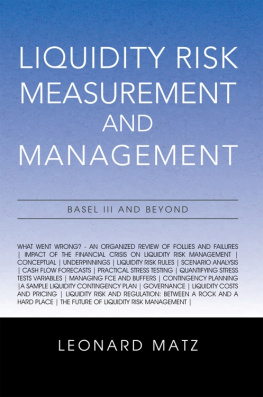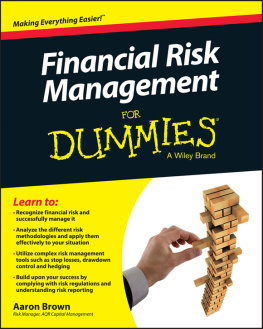Liquidity Risk Measurement and Management
Basel III and Beyond
Leonard Matz
Copyright 2011 by Leonard Matz.
Library of Congress Control Number: 2011912791
ISBN: Hardcover 978-1-4628-9243-3
ISBN: Softcover 978-1-4628-9244-0
ISBN: Ebook 978-1-4628-9245-7
All rights reserved. No part of this book may be reproduced or transmitted in any form or by any means, electronic or mechanical, including photocopying, recording, or by any information storage and retrieval system, without permission in writing from the copyright owner.
This book was printed in the United States of America.
To order additional copies of this book, contact:
Xlibris Corporation
1-888-795-4274
www.Xlibris.com
Orders@Xlibris.com
97596
Contents
What Went Wrong? An Organized Review of Follies and Failures
Managed Buffers for Yield Assuming Markets Would Always Be Liquid
Overconfident that Wholesale Funds Providers Will Always Be Willing to Lend
Tolerated Excessive Liquidity Mismatches
Ignored Worst-Case Stress Tests and the Cassandra Effect
Moved Risks Off-Balance Sheet and Out of Sight
Risk Taking Not Matched by Risk Management
Misallocation of Risk Resources
Misaligned Incentives
Organizational and Execution Weaknesses
Overreliance on Ratings
Failure of Some Institutions to Embrace Forward-Looking Measures
Failed to Perform Worst-Case Stress Tests
Misunderstanding and Misapplying VaR
Insufficient DataEspecially for New Products
Confusion between Risk and Uncertainty
Preparing to Fight the Last War
Severely Underestimated Potential Funding Requirements
Failed to Recognize Risk Linkages and Macro Factors
Capital Is Not a Solution for Liquidity Risk.
Basel II Arbitrage Increased Liquidity Risk on Balance Sheet.
Basel II Arbitrage Contributed to Increases in Off-Balance Sheet Risks
Permitted a Large Increase in Systemic Risk from Banks Reliance on Short-Term Capital Markets Funding.
Almost No Change in Regulation despite Obvious Risks in Mortgage Lending and Securitized Assets
Lack of Cooperation among Regulators
Mark-to-Market Accounting
Impact of the Financial Crisis on Liquidity Risk Management
Measuring Liquidity Risk
Measuring Funding Risk
Organization
Funding Mix
Liquidity Reserve
Funds Transfer Pricing (FTP)
Limit Setting
Contingency Plan
Misallocation of Liquidity
Liquidity Risk and Credit Risk
Conceptual Underpinnings
Why Bother with Old Theories and Basic Facts We All Know Already?
Idiosyncratic Crises
The Commercial or Real Bills Theory of Liquidity
The Shiftability Theory of Liquidity
The Anticipated Income Doctrine of Liquidity
The Liability Management View of Liquidity (or Illiquidity)
The Balance Sheet Management View of Liquidity
Liquidity Risk Rules
Rule 1: Liquidity risk is unavoidable.
Rule 2: Liquidity risk is heterogeneous.
Rule 3: You always have more than you need until you dont.
Rule 4: Scenarios are the language of liquidity risk.
Rule 5: Too little liquidity can kill a bank suddenly, but too much liquidity will kill a bank slowly.
Rule 6: Cash sources and uses are fungible.
Rule 7: Rewards from good liquidity risk management are not directly observable.
Rule 1: Liquidity risk management nets to zero for the system as a whole.
Rule 2: Regulation is necessary but insufficient.
Rule 3: The primary goal must be preservation of confidence in financial institutions. Over time, confidence can only be maintained by preserving the soundness of financial institutions. Soundness, in turn, cannot be maintained without minimizing incentives for management failures.
Scenario Analysis
Liquidity Events Are Often Global and Have Interrelated Elements
Capital Markets Crisis1998
Capital Markets Crisis2007-2008
All for One and One for All
GeneralizingA Classic Bank-Specific Scenario
What Are Silent Runs, Really?
Critical Structural Changes
Agency Risk
Information Asymmetry
Wachovia Reveals an Important Silent Run Perspective
Rush to ExistsA Capital Market Disruption Scenario
Implications for Liquidity Scenario Analysis
Implications for Liquidity Scenario Analysis
Interaction between Funding Liquidity and Market Liquidity
Unfolding of a Systemic Event: The Great Meltdown of 2007-2008
Lessons to be Learned from Scenario Evolution
Cash Flow Forecasts
First DigressionLiquidity Ratios
Advantages of Cash Flow Forecasts
Seven Important Cash Flow Forecast Topics
Scope
Combining Stock Measures and Flow Perspectives
Second DigressionInterest Rate Risk Gaps and Liquidity Gaps Are Similar But Not Identical
Time Buckets and Granularity
Combining Contractual and Behavioral Cash Flows
Contractual Cash Flows and Maturity Transformation
Once Again, This Time with Behavioral Assumptions
Format Is Surprisingly Important
Additional ClarityFCE and CBC
Data
Practical Stress Testing
Historical VaR and Extreme Value Analysis
VaR Is NOT Appropriate for Liquidity Risk
Key Point: Stress Testing Is NOT a Predictive Exercise
If Stress Tests Arent Predictive, Why Stress Test?
Deterministic Scenario Modeling at Multiple Stress Levels
Requirements for Best Practice Stress Tests
Steps for Stress Testing
Stress Testing in Multiple Currencies
Stress Testing for Banks in Groups
Jurisdictional Ring Fencing
Reverse Stress Tests
Backtesting Stress Tests
Quantifying Stress Tests Variables
Normal versus Stress Assumptions
Is a Conservative Bias Necessary?
Is Accuracy a Requirement?
Intrinsic Subjectivity
General Guidelines for Sound Assumptions
Rate Changes and FCEImpact Is Often Overestimated
Loan PrepaymentsA Resource Soak
Rate SwapsA Contra-Example
Rate Changes and CBCImpact Is Often Underestimated
Wrong Method
Wrong Target
First Required Step: Define Stickiness Attributes
Second Required Step: Calculate a Stickiness Score
Third Required Step: Calculate a Stickiness Hierarchy
Fourth Required Step: Generate Estimates for Each Source Type
Quicker and Easier Assumption Sources
Insufficient Distinction of Liquidity and Repricing Lives
The Constraints Are Market Access and Collateral
The Impact of Credit Risk on Market Access
Cash Generated and Consumed by Funded Loans
Cash from Loans Sales and Securitizations
Funding Requirements for Uncommitted Loans
Funding Requirements for Loans Originated for Sale
The Impact of Other Contracts on Funding
Cash, Deposits at Correspondent Banks, and Deposits at the Central Bank
Liquidity and Marketability Are Relative
Understanding Marketability in the Context of Scenarios and Stress Levels
Assets That Can Be Included in the Buffer
Size and Market Price of Buffer Assets
Discounts and Haircuts for Buffer Assets
Managing FCE and Buffers
The Buffer Fallacy and the Management Equivalency
Practical Application
Diversification Does Not Always Reduce Risk
Diversification of Wholesale Funding Sources Does Not Always Reduce Liquidity Risk
Using Diversification Effectively
Two Risk Characteristics
Tactics for Managing Capital Markets Access
Optimize the Overall Size of the Buffer
Optimize the Composition of the Buffer
Control Activities that Consume Buffer Assets
Minimize the Risk of Trapped Collateral
Currency Warning
Even Strong Banks Can Be Impacted
Mange so the Markets and the Public See Your Strength
Next page







